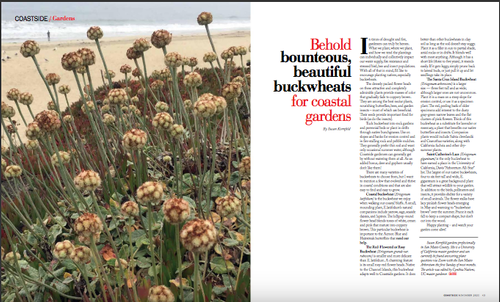In times of drought and fire, gardeners can truly be heroes. What we plant, where we plant, and how we tend the plantings can individually and collectively impact our water supply, fire resistance, and stressed bird, bee, and insect populations. With all of that in mind, I'd like to encourage planting natives, especially, buckwheats.
The densely-packed flower heads on these attractive and completely admirable plants provide masses of color that gradually fade to coppery brown. They are among the best nectar plants, nourishing butterflies, bees, and garden insects – most of which are beneficials. Their seeds provide important food for birds (as do the insects).
Tuck buckwheat into rock gardens and perennial beds or plant in drifts through native bunchgrasses. Use on slopes and banks for erosion control and in fire-stalling rock and pebble mulches. They generally prefer thin soil and want only occasional summer water, although coast side gardeners can generally get by without watering them at all. As an added bonus, deer and gophers usually don't like them!
There are many varieties of buckwheats to choose from, but I want to mention a few that evolved and thrive in coastal conditions and that are also easy to find and easy to grow.
Coastal buckwheat (Eriogonum latifolium) is the buckwheat we enjoy when walking our coastal bluffs. A small, mounding plant, E.latifolium's natural companions include yarrow, sage, seaside daisies, and lupines. The lollipop-round flower head blends tones of white, cream, and pink that mature into coppery brown. This particular buckwheat is important to the Acmon Blue and Hairstreak butterflies that need our help.
The Red-Flowered or Rosy Buckwheat (Eriogonum grande var. rubescens) is smaller and more delicate than E. latifolium. A charming feature is its small rosy-red flower heads. Native to the Channel Islands, this buckwheat adapts well to coastside gardens. It does better than other buckwheats in clay soil as long as the soil doesn't stay soggy. Plant it as a filler in sun to partial shade, amid rocks or in drifts. It blends well with most anything. Although it has a short life (3-5 years), it reseeds easily. If it gets leggy, simply prune back to lateral buds, or just pull it up and let seedlings take its place.
The Santa Cruz Island Buckwheat (Eriogonum arborescens) is a larger size - three feet tall and as wide; although larger ones are not uncommon. Plant it in a mass on a steep slope for erosion control, or use it as a specimen plant. The red, peeling, bark of older specimens add interest to the dusty gray-green narrow leaves and the flat clusters of pink flowers. Think of this buckwheat as a substitute for lavender or rosemary, a plant that benefits our native butterflies and insects. Companion plants would include Salvia clevelandii and Ceanothus varieties, along with California fuchsia and other dry-summer plants.
Saint Catherine's Lace (Eriogonum giganteum) is the only buckwheat to have earned a place in the UC Davis "Arboretum All-Star" list. The largest of our native buckwheats, 4-6 feet tall and wide, E. giganteum is a great background plant that will attract wildlife to your garden. In addition to the birds, pollinators, and insects, it provides shelter for a variety of small animals. The flower stalks have lacy pinkish flower heads emerging in May and warming to "buckwheat brown" over the summer. Prune it each fall to keep a compact shape, but don't cut into the wood.
Happy planting – and watch your garden come alive!
Susan Kornfeld gardens professionally in San Mateo County. She is a UC Master Gardener and can currently be found answering plant questions via Zoom with the San Mateo Arboretum the first Sunday of most months. The article was edited by Cynthia Nations, UC Master Gardener.
Attached Images:
